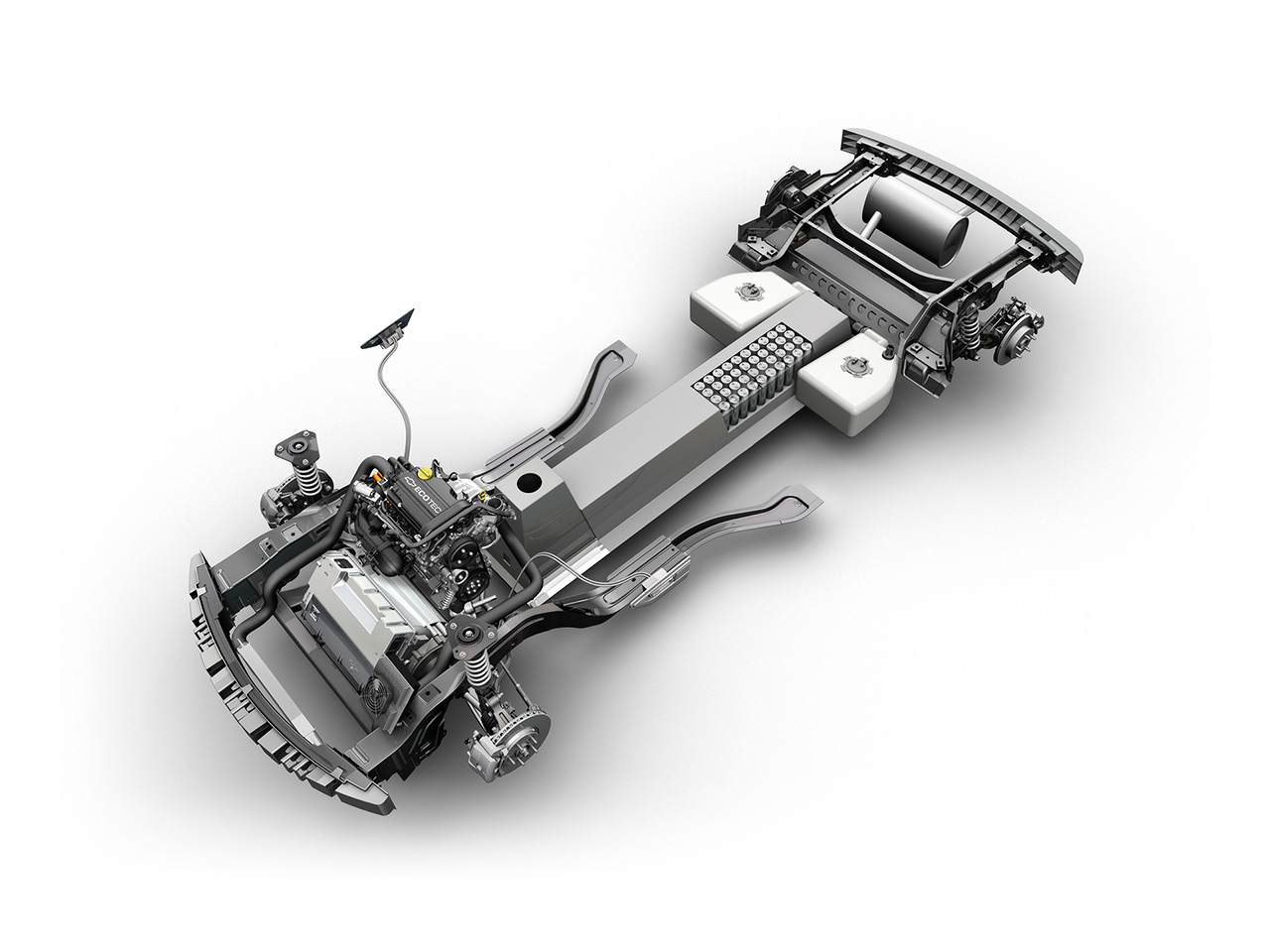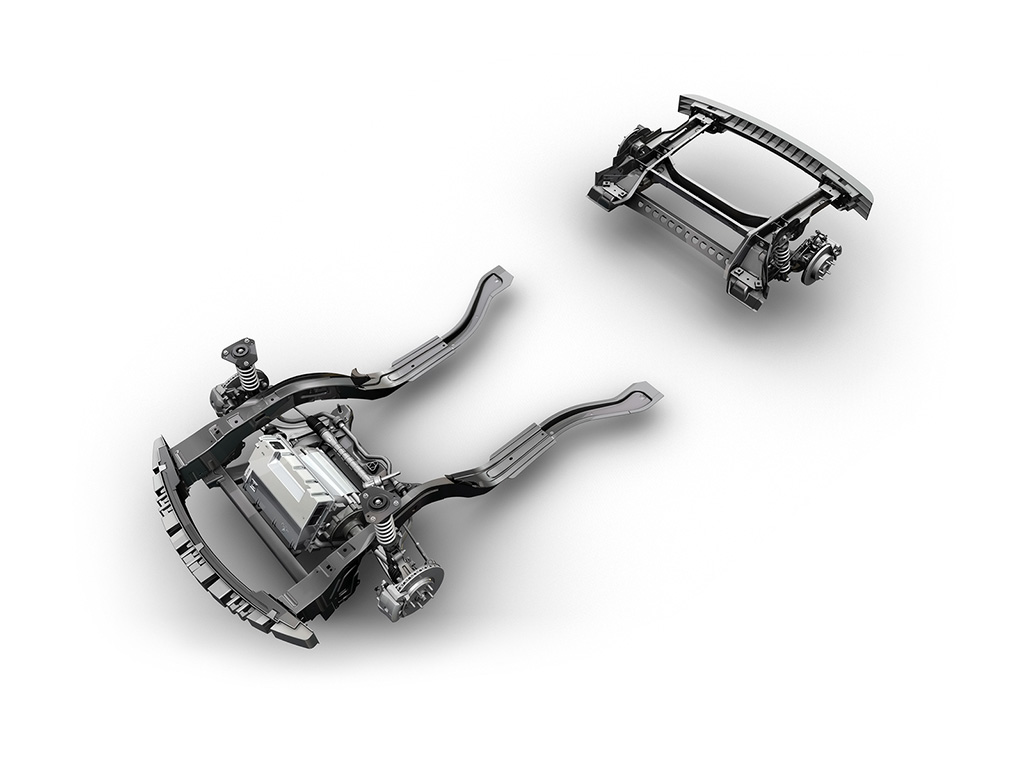2007 Chevrolet Volt Concept
|
Price |
-- |
Production |
-- | ||
|
Engine |
Electric w/3-cyl |
Weight |
-- | ||
|
Aspiration |
turbo (3 cylinder motor) |
Torque |
-- | ||
|
HP |
174 - 188 hp (electric) |
HP/Weight |
-- | ||
|
HP/Liter |
-- |
1/4 mile |
-- | ||
|
0-62 mph |
8 - 8.5 seconds |
Top Speed |
120 mph |
(from General Motors Press Release) CHEVROLET VOLT CONCEPT’S SPIRITED DESIGN PROVES ENVIRONMENTALLY CONSCIOUS VEHICLES CAN OFFER EXCITING STYLING
DETROIT – While the
technologically advanced Chevrolet Volt has the capability to travel
40 miles on electricity alone, at first glance, the concept could
easily be mistaken as simply a design statement.
The Volt conveys an immediate message of agility and sophistication,
with exterior proportions more commonly associated with classic
sports cars. Twenty-one-inch wheels and sheer, taut surface
relationships reiterate the statement. The Chevrolet Volt’s athletic
design challenges the notion that an environmentally conscious
vehicle can’t be beautiful and possess an aesthetic spirit that
matches its driving characteristics.
“We’ve leveraged our resources around the globe to develop the
design aesthetic for the Volt,” said Ed Welburn, vice president, GM
Global Design. “It was important that the design capture the face of
Chevrolet as it’s recognized around the world.” Design and
engineering collaboration between GM designers and GE Plastics,
using unique material technology and design engineering support,
helped achieve the Volt’s distinctive appearance. True to the
heritage of its Chevrolet bowtie, the Volt’s exterior design
suggests spirited performance and is wrapped in a stylish package,
with classic Chevrolet performance cues that hint at both Camaro and
Corvette.
Inside, a host of current or near-term technologies and materials,
combined with ingenious use of ambient light, creates an interior
environment that’s light, airy and thoughtful.
“First and foremost, this is an advanced technology vehicle that
uses little or no fuel at all. But we didn’t see any reason why that
should compromise its design,” said Anne Asensio, executive
director, GM Design. Asensio led the design team that created the
Volt concept, with designs solicited from GM’s studios around the
world.
“We wanted a size that connected with everyone, so we designed a
small car,” said Asensio. “In the end, the interior design team from
England inspired the final interior execution, and the exterior was
the work of the Michigan advanced design team.
“Our job was to design a vehicle people could easily imagine seeing
on the road,” said Asensio. “It couldn’t be a ‘science project,’
because that’s not what this car is all about. It had to be
realistic, executable and carry the essence of the Chevrolet brand.”
Athletic, bold exterior
Sized for an
urban-centric lifestyle, the Volt concept sedan carries dimensions
similar to a Chevrolet Cobalt, with an overall length of
approximately 170 inches (4,318 mm), a height of 52.6 inches (1,336
mm) and a width of 70.5 inches (1,791 mm). However, the Volt’s
proportions, dictated by the layout of its electrically driven
powertrain system, make it distinctly different from its mainstream
Cobalt sibling.
“The configuration of the drive and energy components dictated we
push the front wheels forward and outward to the corners,” said Bob
Boniface, design director, GM Design, and lead exterior designer.
“We wanted to keep the overall dimensions relatively small. This is
an urban-centric car, so it needs to fit into small areas.”
The Volt’s proportions, combined with large wheels, wide front and
rear tracks (64 inches / 163 mm, front and rear) and a tight
wheel-to-body relationship, enable a sporty, confident stance. Other
key proportional highlights include a dash-to-axle length that
positions the driver far rearward of the front wheels; large 21-inch
by 7.5-inch wheels; short front and rear overhangs and departure
angles that deliver a sense of taut, compact energy. Also, the
offsets between the upper glass elements and tire planes (the glass
is inboard of the face of the tires) contribute to the sedan’s
balanced stance and enhance the vehicle’s dynamic static image,
resulting in pure, athletic proportions.
“What’s beautiful about the proportions is that when you think about
some of the competitors out there, you tend to think of those
vehicles as ‘the sensible shoe,’ “said Boniface. “People buy
environmentally friendly cars because they feel it’s the right thing
to do, not necessarily because of their looks or to make a fashion
statement. But the Volt is different. It’s something one would buy
because it is so compelling to look at, and the fact that it has the
potential to never burn any gasoline – that’s just a bonus.”
Transparent roof and beltline
The Volt’s roof, side
glass and beltline are constructed of GE Plastics transparent,
glazed polycarbonate material that delivers the scratch resistance
and gloss surface appearance of glass, combined with the formability
of a plastic composite.
As a result, the Volt provides the driver and occupants with
exceptional visibility, enabling a “city lights” theme in which the
outside world passes through to the interior of the vehicle. Also
contributing to the visibility is a shouldered, tinted side glass –
constructed of the same GE polycarbonate material – that enables a
dual beltline.
Additional exterior design elements
In addition to the upper
daylight opening and roof, key exterior panels are made with a GE
Plastics composite, and each – in and of itself – is designed as an
artful shape that could be displayed on its own. As a result, the
exterior panels fit together like a well-crafted puzzle, with
flowing surface-to-surface cut lines that bring a sophisticated
composition and overall harmony to the Volt’s exterior appearance.
The front door hinges enable enhanced entry/egress to the vehicle,
as well as a graceful, forward-leaning door cut line. Milled from
billets of stainless steel, the hinges serve as design elements,
extending into the front quarter fenders and incorporating a plug-in
recharging port access on both sides of the vehicle.
The vehicle face – designed to carry a serious, confident appearance
– is clearly Chevrolet, with a twin-port front grille,
center-positioned bowtie and lower air intake. Horizontal headlamps
with aluminum bezels deliver a jeweled appearance, leading to
translucent light-emitting diode (LED) forward illumination
elements.
The underside of the vehicle consists of a flat, composite molded
belly pan that is integrated with the fascias and rockers for a
clean, uncluttered and finished appearance. The belly pan – which
contributes significantly to the Volt’s 0.30 coefficient of drag –
contributes to the sedan’s overall impression of refinement and
demonstrates the design of the underbody was just as important as
the upper body.
Thoughtful interior
The interior environment
of the Volt was designed to appeal to an urban dweller who desires a
smart, daily-use vehicle, according to Wade Bryant, design director,
GM Design.
“On the interior of the Volt, you’ll find technologies, materials
and an environment that enable the car to help make life simpler for
a person who’s environmentally conscious and leads a city-centered
lifestyle,” said Bryant. “It’s ergonomically correct, provides
connectivity to the world, and demonstrates smart responsibility
through the use of lightweight, recyclable materials.” Two such
examples are the instrument panel topper and steering wheel made
with GE Plastics.
Bryant said the interior environment of the four-passenger Volt is
defined by a host of current or near-term technologies and materials
combined with the ingenious use of ambient light. “It’s definitely
based in reality. All the things you see on the interior are within
reach in the next few years.”
According to Bryant, the interior team and the exterior designers
worked closely together to make the Volt look like one vehicle. Two
examples of their collaboration are the dual beltline and the door
hinge that’s visible outside of the car. “We designed this as one
element that comes inside the door and becomes the interior pull
handle,” said Bryant. “It’s all about integration, refinement and
thoughtfulness.”
Super Imaging instrument cluster
Super Imaging is an
innovative, dual-mode technology display that provides two visual
levels of vehicle information to the driver in the instrument
cluster. It is a design innovation developed to provide a primary
interface between the driver and the vehicle’s key feature: the
next-generation, electrically driven propulsion system.
“The dual-mode instrument cluster was developed to highlight the
car’s plug-in capability,” said Bryant. “The powertrain technology
is the key feature, so we wanted to make sure the interior
communicated that, and the driver would have a sophisticated, fun
and useful interaction with the electric-drive system.”
The first level of information – configured similarly to a
conventional instrument cluster – provides traditional data in the
form of analog, three-dimensional (3D) LED displays, including three
gauges for fuel level, speedometer, odometer, battery level and the
transmission “PRNDL” indicator. The second level of information – a
transparent screen positioned in front of the 3D LED displays –
delivers color, animated data related to the Volt’s advanced
propulsion system with a holographic-like appearance.
Super Imaging works by using invisible, fluorescent inks that are
printed on the transparent screen. When illuminated by an
ultraviolet (UV) laser projector located behind the instrument
cluster (from the driver’s perspective), the inks become excited,
and provide four-color illumination and animation.
Foam/fabric surfaces
Compression-molded foam
with a textile-patterned surface layer is applied on the entire
lower instrument panel, lower door trim panels and rear quarter trim
areas. The material enables soft, tactile, low-gloss surfaces
throughout the interior cabin that appear hand-crafted and
specifically tailored to the car.
This material, used in some of the latest luggage designs, enables
zippered access to traditional storage areas such as the glove box,
doors, etc. The material is very inexpensive, wears well and enables
flexibility in design.
Composite panels
Molded GE plastic panels
provide thin, structural interior surfaces that can be cantilevered
in space. The material is applied on the upper instrument panel,
seat backs, center console sides and door inserts.
Light, strong, affordable and recyclable, the panels are sheathed in
reconstructed scrap leather to achieve a soft, hand-crafted surface.
Use of ambient light
The aspect of light –
from outside and within the vehicle – is played throughout the
interior environment. Highlights include a transparent upper roof
that provides large quantities of natural light and is enhanced with
thinner pillars and rail sections; Gelcore® LED indirect lighting
around the roof periphery that illuminates during evening hour
entry/egress and can be seen from outside the vehicle; LED
functional storage lighting that passes through transparent zippers
and provides ambient light during evening hours; and conductive ink
controls situated on the interior surface of the glass roof that
provide touch access to lights, OnStar buttons and more.
“All the storage areas are lighted internally, and the light escapes
through the clear zippers, so you’ll always be able to find your
storage at night,” Bryant said. “It all adds a nice little ambient
effect, and the illumination will be color-keyed to the
instrumentation lighting color. It’s functional and cool, and when
you open it, light from the interior storage area spills out.
“A big enabler is the transparent upper roof. It provides the Volt
with more natural light than most other vehicles. It’s very
distinctive and appealing.”



